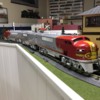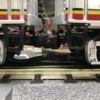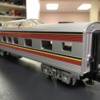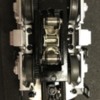To start, take a dry towel (would be best if you had a lint free one) but for this any small towel or rag will work as long as it’s clean.
Begin by wiping all the flat surfaces of the trucks and wheels and the pickup rollers for the middle rails.
Next you will need some rubbing alcohol. You will use this to just clean the wheels. The easiest way to do this is to power up the engine while it’s upside down and press a small part of the towel that has been dipped in the rubbing alcohol against just the wheel surface as it rotates. For best results, you will need some alligator clip test leads to do this. However, if you don’t have those, you can do it the slow way. This would be to clean the surface of all the wheels as best you can using q-Tips dipped in the rubbing alcohol. Then put the engine on the track and power it up slowly so that it moves only one inch or so and take itt off and do more cleaning. Rubbing alcohol isn’t good for your traction tires, but neither is being covered in oil. So you can either replace them after the trucks and wheels have been completely cleaned with oil or try and clean them first with the rubbing alcohol.
Something to watch out for though. If there is a lot of oil on the wheels, there may be some hiding under the traction tire. If this is the case, then just cleaning the surface of the tire may not be good enough. You may need to remove the tires and clean everything (including the inside and outside of the tires) and then put them back on.
You don’t need to clean the oil off of the gears. That’s one of the places that you do want to be oiled, but with the amount you have right now, you shouldn’t need to add any more for a long time.
When you finally have the engine all cleaned up, you will want to clean your track as well. use a clean part of the towel and some more rubbing alcohol and wipe down all of your track.
Fianlly, if you are serious about this, there are better cleaners to use other than “off the shelf” rubbing alcohol. But if you haven’t done this before, this would be a good start. Just use it sparingly. You definitely down want this dripping everywhere as you do it. You only want it on the areas you are trying to clean.









